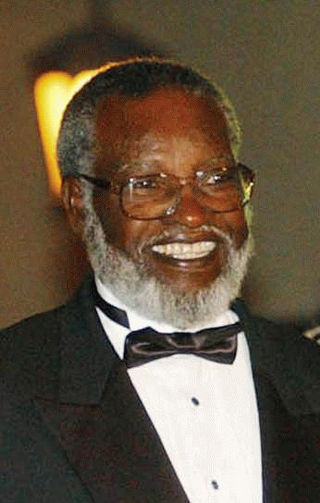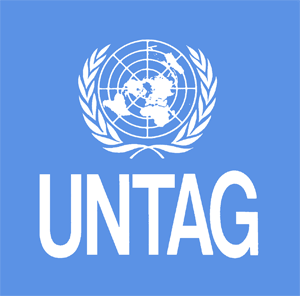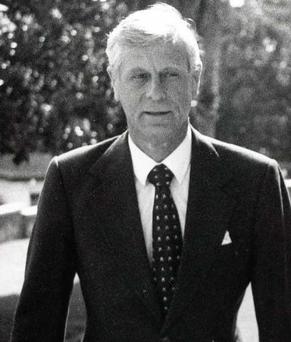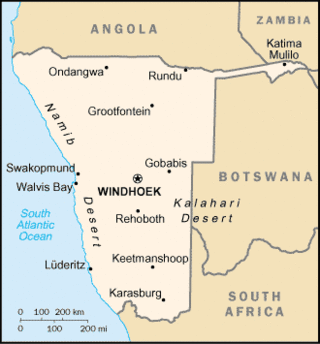Related Research Articles
The history of Namibia has passed through several distinct stages from being colonised in the late nineteenth century to Namibia's independence on 21 March 1990.

Samuel Shafiishuna Daniel Nujoma, is a Namibian revolutionary, anti-apartheid activist and politician who served three terms as the first President of Namibia, from 1990 to 2005. Nujoma was a founding member and the first president of the South West Africa People's Organization (SWAPO) in 1960. Prior to 1960, SWAPO was known as the Ovambo People's Organisation (OPO). He played an important role as leader of the national liberation movement in campaigning for Namibia's political independence from South African rule. He established the People's Liberation Army of Namibia (PLAN) in 1962 and launched a guerrilla war against the apartheid government of South Africa in August 1966 at Omungulugwombashe, beginning after the United Nations withdrew the mandate for South Africa to govern the territory. Nujoma led SWAPO during the lengthy Namibian War of Independence, which lasted from 1966 to 1989.

The South African Border War, also known as the Namibian War of Independence, and sometimes denoted in South Africa as the Angolan Bush War, was a largely asymmetric conflict that occurred in Namibia, Zambia, and Angola from 26 August 1966 to 21 March 1990. It was fought between the South African Defence Force (SADF) and the People's Liberation Army of Namibia (PLAN), an armed wing of the South West African People's Organisation (SWAPO). The South African Border War resulted in some of the largest battles on the African continent since World War II and was closely intertwined with the Angolan Civil War.
Operation Displace was a military operation by the South African Defence Force during the South African Border War and Angolan Civil War. It involved maintaining the illusion that the SADF had remained in brigade strength east of Cuito Cuanavale at the end of April 1988 and the eventual withdrawal of all South African military units from south-eastern Angola during August 1988.
Operation Prone was a proposed military operation by the South African Defence Force (SADF) and South West African Territorial Force (SWATF) during the South African Border War and Angolan Civil War between May and September 1988. With the advance of the 50th Cuban Division towards Calueque and the South-West Africa border, the SADF formed the 10 SA Division to counter this threat. The plan for Operation Prone had two phases. Operation Linger was to be a counterinsurgency phase and Operation Pact a conventional phase.

Chester Arthur Crocker is an American diplomat and scholar who served as Assistant Secretary of State for African Affairs from June 9, 1981, to April 21, 1989, in the Reagan administration. Crocker, architect of the U.S. policy of "constructive engagement" towards Southern Africa including apartheid-era South Africa, is credited with setting the terms of Namibian independence.

The United Nations Transition Assistance Group (UNTAG) was a United Nations (UN) peacekeeping force deployed from April 1989 to March 1990 in Namibia, known at the time as South West Africa, to monitor the peace process and elections there. Namibia had been occupied by South Africa since 1915, first under a League of Nations mandate and later illegally. Since 1966, South African forces had been combating an insurgency by the People's Liberation Army of Namibia (PLAN), the military wing of the Namibian-nationalist South West African People's Organization (SWAPO). The UN Security Council passed Resolution 435 in 1978, which set out a plan for elections administered by South Africa but under UN supervision and control after a ceasefire. However, only in 1988 were the two parties able to agree to a ceasefire. As UNTAG began to deploy peacekeepers, military observers, police, and political workers, hostilities were briefly renewed on the day the transition process was supposed to begin. After a new round of negotiations, a second date was set and the elections process began in earnest. Elections for the constitutional assembly took place in November 1989. They were peaceful and declared free and fair; SWAPO won a majority of the seats. The new constitution was adopted four months later and it was followed by Namibia's official independence and the successful conclusion of UNTAG.
The Agreement among the People's Republic of Angola, the Republic of Cuba, and the Republic of South Africa granted independence to Namibia from South Africa and ended the direct involvement of foreign troops in the Angolan Civil War. The accords were signed on 22 December 1988 at the United Nations Headquarters in New York City by the Foreign Ministers of People's Republic of Angola, Republic of Cuba and Republic of South Africa.

Louis Alexander Pienaar was a South African lawyer and diplomat. He was the last white Administrator of South-West Africa, from 1985 through Namibian independence in 1990. Pienaar later served as a minister in F W de Klerk's government until 1993. He married Isabel Maud van Niekerk on 11 December 1954.

United Nations Commissioner for South West Africa was a post created by the United Nations General Assembly (UNGA) in 1966 to assert the UN's direct responsibility for South West Africa which was then under illegal occupation by apartheid South Africa.

United Nations Security Council Resolution 435, adopted on September 29, 1978, put forward proposals for a cease-fire and UN-supervised elections in South African-controlled South West Africa which ultimately led to the independence of Namibia. Importantly, it established the United Nations Transition Assistance Group (UNTAG) which oversaw the election and the South African withdrawal.

The Cuban intervention in Angola began on 5 November 1975, when Cuba sent combat troops in support of the communist-aligned People's Movement for the Liberation of Angola (MPLA) against the pro-western National Union for the Total Independence of Angola (UNITA) and National Liberation Front of Angola (FNLA). The intervention came after the outbreak of the Angolan Civil War, which occurred after the former Portuguese colony was granted independence after the Angolan War of Independence. The civil war quickly became a proxy war between the Eastern Bloc led by the Soviet Union and the Western Bloc led by the United States. South Africa and the United States backed UNITA and the FNLA, while communist nations backed the MPLA.

Namibia–South Africa relations refers to the current and historical relationship between Namibia and South Africa. South Africa captured the area now known as Namibia from Germany during World War I and governed it, by the name 'South West Africa', until 1990, when the country gained independence under the name 'Namibia'. During those 75 years, thousands of South Africans settled in the territory and South Africa treated the area as an internal province, imposing apartheid laws in South West Africa as it did in South Africa.

Cuba–Namibia relations are the bilateral relations between Cuba and Namibia. Both nations are members of the Group of 77, Non-Aligned Movement and the United Nations.
The 1978 Settlement Proposal in Namibia, devised by the Contact Group of Western States, mandated the United Nations Transition Assistance Group (UNTAG) under United Nations Security Council Resolution 435 to assist a UN Special Representative appointed by the UN Secretary-General 'to ensure the early independence of Namibia through free and fair elections under the supervision and control of the United Nations'.

United Nations Security Council resolution 629, adopted unanimously on 16 January 1989, after recalling resolutions 431 (1978), 435 (1978) and 628 (1989), the council noted that the parties to the Brazzaville Protocol agreed that 1 April 1989 be established as the date of the South African withdrawal from Angola and therefore lead the way to the independence of Namibia.
Tuliameni Kalomoh is a Namibian diplomat who has among other portfolios served as Special Advisor on Foreign Affairs to the President, Prime Minister and Minister of Foreign Affairs of the Republic of Namibia.

Namibia–United Kingdom relations are the bilateral relations between Namibia and the United Kingdom. Both nations are members of the Commonwealth of Nations and the United Nations.

The Australian Services Contingent was the Australian Army contribution to the United Nations Transition Assistance Group (UNTAG) peacekeeping mission to Namibia in 1989 and 1990. Australia sent two contingents of over 300 engineers each to assist the Special Representative of the Secretary General, Martti Ahtisaari, in overseeing free and fair elections in Namibia for a Constituent Assembly in what was the largest deployment of Australian troops since the Vietnam War.
Operation Merlyn was a military operation by the South African Defence Force (SADF), South West African Territorial Force (SWATF) and South West African Police (SWAPOL) during the South African Border War and Angolan Civil War in April 1989. The aim of the operation was to prevent the incursion of PLAN (SWAPO) insurgents into South West Africa/Namibia from bases in Angola. These incursions were in violation of a ceasefire which came into effect on 1 April 1989 via the implementation of United Nations Security Council Resolution 435 and the Tripartite Accord. Initially, these PLAN incursions were tackled by South West African police units and eventually by SADF and SWATF units, released to assist the police having been confined to their bases by the peace agreements. These incursions and the conflict that occurred ended after hastily arranged talks resulted in the Mount Etjo Declaration and an eventual ceasefire.
References
- ↑ Jochen Prantl (2006). The UN Security Council and Informal Groups of States: Complementing or Competing for Governance. Oxford University Press. ISBN 978-0-19-928768-0 . Retrieved 2009-01-17.
- ↑ Henneberg, Ingo (2020). "International contact groups: Ad hoc coordination in international conflict management". South African Journal of International Affairs. 27 (4): 445–472. doi:10.1080/10220461.2020.1877190. S2CID 231875749.
- ↑ "Tripartite Agreement: Angola, Cuba and South Africa". United States Institute of Peace. Retrieved 2009-01-17.